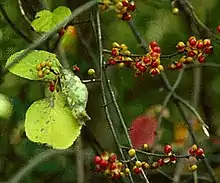Celastraceae
The Celastraceae (staff-vine or bittersweet) are a family of 97 genera and 1,350 species[3] of herbs, vines, shrubs and small trees, belonging to the order Celastrales. The great majority of the genera are tropical, with only Celastrus (the staff vines), Euonymus (the spindles) and Maytenus widespread in temperate climates, and Parnassia (bog-stars) found in alpine and arctic climates.
| Celastraceae | |
|---|---|
 | |
| Oriental staff vine (Celastrus orbiculatus) | |
| Scientific classification | |
| Kingdom: | Plantae |
| Clade: | Tracheophytes |
| Clade: | Angiosperms |
| Clade: | Eudicots |
| Clade: | Rosids |
| Order: | Celastrales |
| Family: | Celastraceae R.Br.[1] |
| Subfamilies[2] | |
| |
Of the 97 currently recognized genera of the family Celastraceae, 19 are native to Madagascar and these include at least 57 currently recognized species. Six of these 19 genera (Brexiella, Evonymopsis, Hartogiopsis, Polycardia, Ptelidium, and Salvadoropsis) are endemic to Madagascar.[4] Celastrus, Euonymus, Maytenus, Salacia, and Tripterygium are a few of the genera that belong to the Celastraceae family that are quite popular. These genera each have distinctive traits and functions of their own.[5]
Genera
A complete list of the genera is:
- Acanthothamnus
- Allocassine
- Anthodon
- Apatophyllum
- Apodostigma
- Arnicratea
- Bequaertia
- Brassiantha
- Brexia
- Brexiella
- Campylostemon
- Canotia – crucifixion thorn
- Cassine
- Catha – khat
- Celastrus – staff vine or staff tree
- Cheiloclinium
- Crocoxylon
- Crossopetalum
- Cuervea
- Denhamia
- Dicarpellum
- Dinghoua
- Elachyptera
- Elaeodendron
- Empleuridium
- Euonymus – spindle
- Evonymopsis
- Fraunhofera
- Gloveria
- Glyptopetalum
- Goniodiscus
- Gyminda
- Gymnosporia
- Hartogiella
- Hartogiopsis
- Hedraianthera
- Helictonema
- Hexaspora
- Hippocratea
- Hylenaea
- Hypsophila
- Kokoona
- Lauridia
- Lepuropetalon
- Loeseneriella
- Lophopetalum
- Lydenburgia
- Macgregoria
- Maurocenia
- Maytenus – maiten
- Menepetalum
- Microtropis
- Monimopetalum
- Mortonia
- Moya
- Mystroxylon
- Nicobariodendron
- Orthosphenia
- Parnassia
- Paxistima
- Peripterygia
- Peritassa
- Plagiopteron
- Platypterocarpus
- Plenckia
- Pleurostylia
- Polycardia
- Pottingeria
- Prionostemma
- Pristimera
- Psammomoya
- Pseudocatha
- Pseudosalacia
- Ptelidium
- Pterocelastrus
- Putterlickia
- Quetzalia
- Reissantia
- Robsonodendron
- Rzedowskia
- Salacia
- Salacighia
- Salaciopsis
- Salvadoropsis
- Sarawakodendron
- Scandivepres
- Schaefferia
- Semialarium
- Simicratea
- Simirestis
- Siphonodon
- Stackhousia
- Tetrasiphon
- Thyrosalacia
- Tontelea
- Torralbasia
- Tricerma
- Tripterococcus
- Tripterygium
- Tristemonanthus
- Wimmeria
- Xylonymus
- Zinowiewia
- Fossil genera
References
- Angiosperm Phylogeny Group (2009). "An update of the Angiosperm Phylogeny Group classification for the orders and families of flowering plants: APG III". Botanical Journal of the Linnean Society. 161 (2): 105–21. doi:10.1111/j.1095-8339.2009.00996.x.
- "Celastraceae R. Br., nom. cons". Germplasm Resources Information Network. United States Department of Agriculture. 2003-01-17. Archived from the original on 2009-05-06. Retrieved 2009-04-16.
- Christenhusz, M. J. M. & Byng, J. W. (2016). "The number of known plants species in the world and its annual increase". Phytotaxa. 261 (3): 201–17. doi:10.11646/phytotaxa.261.3.1.
- Bacon, Christine D.; Simmons, Mark P.; Archer, Robert H.; Zhao, Liang-Cheng; Andriantiana, Jacky (2016). "Biogeography of the Malagasy Celastraceae: Multiple independent origins followed by widespread dispersal of genera from Madagascar" (PDF). Molecular Phylogenetics and Evolution. 94 (Part A): 365–82. doi:10.1016/j.ympev.2015.09.013.
- Abubakari, Farida; Nkrumah, Philip Nti; Erskine, Peter D.; Brown, Gillian K.; Fernando, Denise R.; Echevarria, Guillaume; van der Ent, Antony (2021-06-01). "Manganese (hyper)accumulation within Australian Denhamia (Celastraceae): an assessment of the trait and manganese accumulation under controlled conditions". Plant and Soil. 463 (1): 205–223. doi:10.1007/s11104-021-04833-z. ISSN 1573-5036.